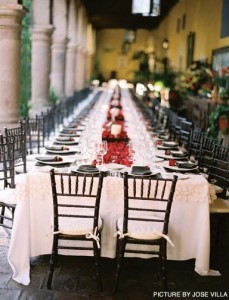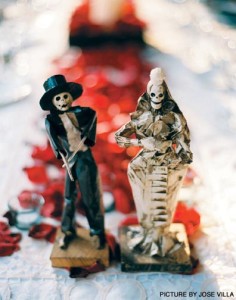Latino Themed Weddings
Latino Theme Weddings: A throw back to Traditions
¡Felicidades! You’re getting married. We’ve got some great ideas with Latin Flair to help make your fiesta fabulous.
¿A Donde Casarse? (Where to Marry)
Choose a meaningful spot for your wedding. Look for a place that holds Latin-American significance, such as a cultural museum, an important church, a historical site, or a Latin-owned restaurant. Or look for a site with a Latin feel, like a Spanish mission, a hacienda, or even the tropical foliage in a local botanical garden. And don’t forget about the decorations: use brightly colored linens, flowers, and pottery. You can even hang piñatas from the ceiling. At Puerto Rican weddings, a doll dressed in a bridal gown is placed at the head table.
Para La Novia (For the Bride)
Trying to decide on your vestido de bodas (wedding dress)? For a subtle Latin feel consider wearing a dramatic mantilla veil, or a slim dress with a bolero jacket. Or look for a dress with Flamenco-style ruffles at the hem. Need something blue? Brides in many Latin-American countries wear a light blue petticoat or slip beneath their dresses. White not your color? Well, in Spain, brides wear black dresses to show their devotion until death. Touches of red and black, for both bride and groom, also add a Latin touch. But, if this seems like too much for you to handle, consider dressing your wedding party in red and black. Check out our Bridal Gown Gallery!
La Procesión (The Procession)
Who’s walking you down the aisle? At Argentinean weddings as well as many Latin countries, her father escorts the bride. There are no bridesmaids or groomsmen, and only the couple’s parents and padrinos stand with them at the altar.
Arras (Coins)
During Catholic ceremonies in Spain, Panama, and Mexico, the groom presents the bride with 13 gold coins, known as Arras, to represent his ability to support the bride. The coins are blessed by the priest and passed through the hands of the newlyweds several times, ending up with the bride. Want to make the ritual a little more balanced? Consider giving each other coins, to symbolize shared responsibility.
Los Anillos (The Rings)
Not everyone waits until their big day to get their wedding bands. In Chile, engaged couples wear rings on their right hand until they are married and switch to the left hand after the wedding. Argentinean couples also exchange rings when they get engaged.
Madrinas y Padrinos (Godparents)
Throughout Latin America, specially chosen godparents guide couples through their wedding ceremony. In Mexico, madrinas and padrinos serve as wedding sponsors, supporting the couple both financially and spiritually. In Bolivia and Ecuador, compadres or compadrazgo are chosen either at birth or marriage. They play a large role in the wedding, and continue to support the couple throughout their lives.
Ate el Nudo (Tie the Knot)
In Guatemala, the couple binds themselves together during the ceremony with a silver rope. Mexican couples perform a similar ritual, where a rosary or white rope, el laso, is wound around their shoulders in a figure eight to symbolize their union. While the couple is bound together, the priest may recite the following: “Let the union of binding together this rosary of the Blessed Virgin Mary be an inspiration to you both. Remember the holiness necessary to preserve your new family can only be obtained by mutual sacrifice and love.”
Bebidas (Drinks)
Time to celebrate! Have your bartender mix up a giant batch of sangria, a delicious punch made from a secret combination of wine, brandy, sugar, fruit, and seltzer. Or serve a selection of Latin-American cocktails such as Caipirinha, a Brazilian potion of fresh lime juice, sugar, and sugar cane liquor; and the time-tested Cuban favorite, rum and Coke. As for wine, Chile, Argentina, and Spain all produce excellent white, red, and sparkling wines. For non-alcoholic drinks, Mexican sodas come in a variety of tropical flavors, and batidos are popular fruit shakes made from fresh fruit, ice and milk. And don’t forget to serve some strong cafe con leche with your wedding cake.
Comidas Latinas (Latino Food)
For appetizers, try pastelitos, Puerto Rican meat patties, or empanadas, Colombian pastries stuffed with meat and vegetables. Spanish tapas make perfect appetizers. These bite-sized morsels come in an astounding variety, such as pickles, olives, spicy veggies, cheeses, omelets, garlic shrimp, and chunks of grilled peasant bread. For real Latin-American flavor set up stations of make-your-own fajitas and tacos. Other must-have dishes include rice and beans, paella, arroz con pollo (chicken with rice), ropa vieja (beef stew), and plantains (fried bananas). And for dessert? Flan, of course. This delicious custard made from milk, eggs, vanilla, and caramelized sugar is the perfect way to end the night. In Mexico, Panama, and throughout the Caribbean, traditional wedding cakes are made with nuts and dried fruit, and are soaked in lots of rum. Check out our Caterer Vendors!
Bailemos (Let’s Dance)
There is an endless variety of Latin music to choose from: salsa, merengue, mambo, flamenco, and samba, to name just a few. For a really dramatic first dance, take some tango lessons before your big day, and surprise your guests with a performance. Hire a Mexican mariachi group or Cuban big band to get everyone dancing. Before the dancing really begins at Mexican weddings, guests gather around the couple in a heart-shaped ring. Cuban and other Latin weddings often include a money dance, in which each man who dances with the bride attaches money to her gown.
Recuerdos (Gift Favors)
In Puerto Rico, small favors, called capias, are presented to the guests in a receiving line. They are made of feathers tied with ribbon and printed with the couple’s names and wedding date. For your wedding, you can give guests little Mexican wedding cookies wrapped in tulle, Spanish fans, a volume of Pablo Neruda’s love poems, or note cards with paintings by Frida Kahlo or Diego Rivera tied with ribbon. If you’re up for it, the little bride and groom skeletons used during the Mexican holiday Día de los Muertos (Day of the Dead, which is really a celebration of life) would be perfect favors.
¿Donde Están? (Where Are They?)
Can’t wait for the honeymoon to begin? Well, in Venezuela, it isn’t uncommon for a couple to sneak away from their own reception. But no one gets upset once they discover the newlyweds are missing — it’s actually considered good luck.
















